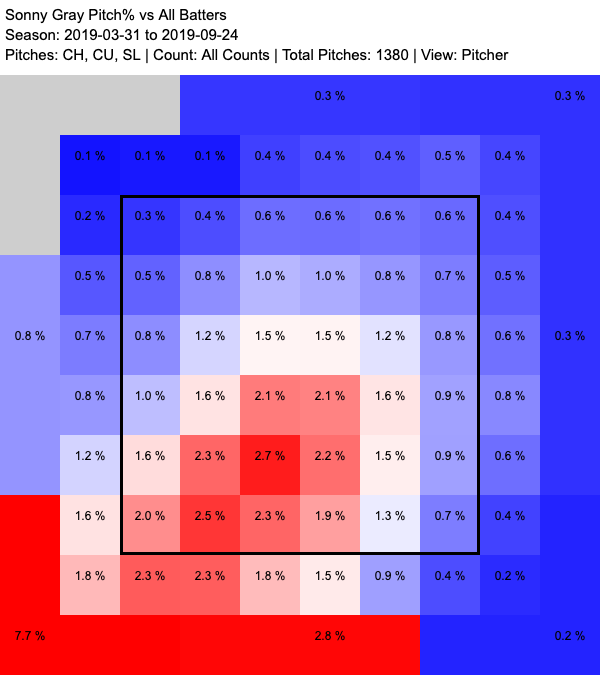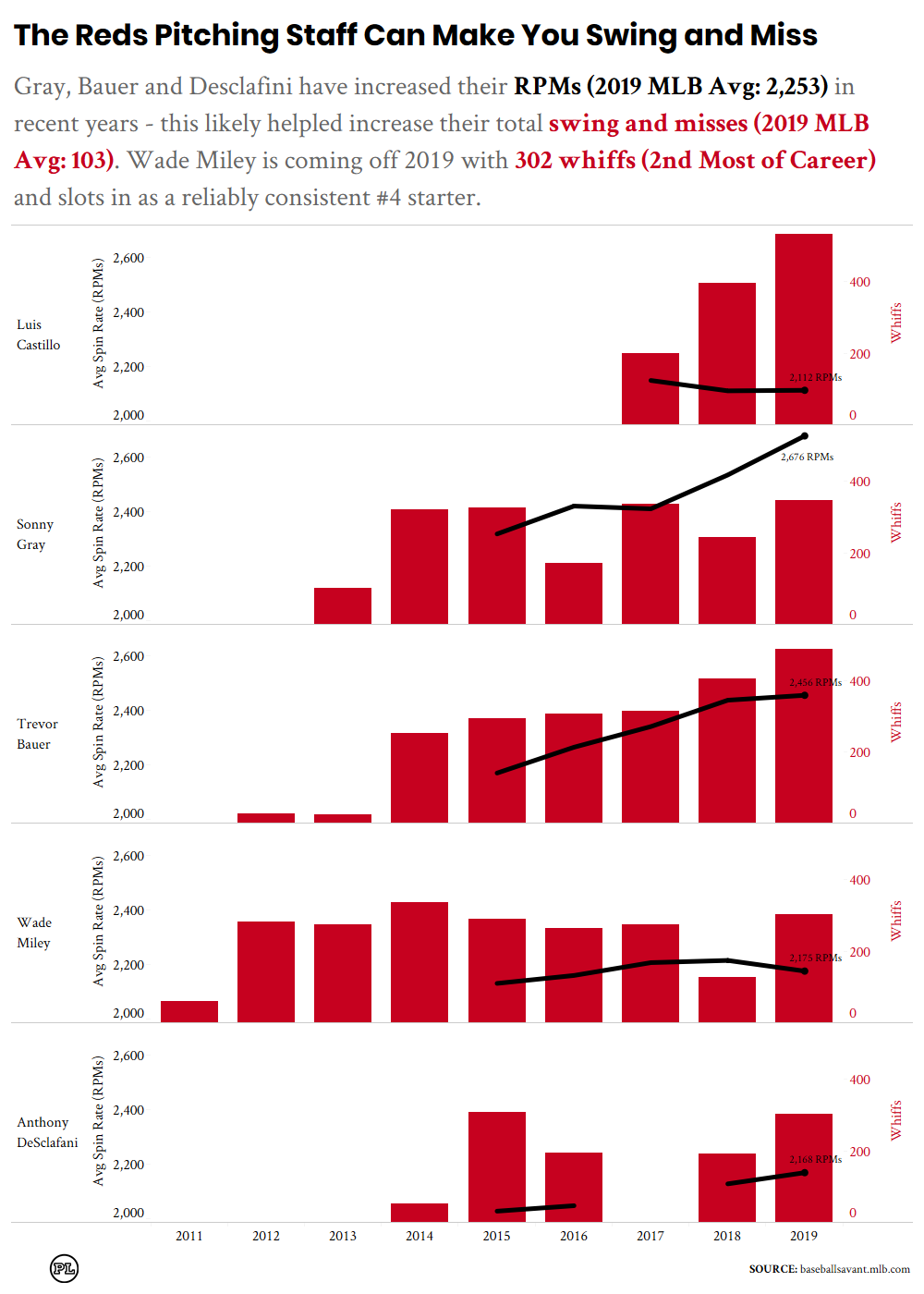Don’t look now (all right, look for the sake of my article views) but the Cincinnati Reds—yes, they of the Homer Bailey devotion, the franchise that once threw Scott Feldman out on the mound as an Opening Day starter—are shaping up to have one of the best pitching rotations in all of baseball. If you’re at all familiar with the Big Red Machine, you’ll know that “Cincinnati” and “elite rotation” have been antithetical terms in recent years, but 2020 has the possibility of being a mini-renaissance for the boys on Joe Nuxhall Way.
Taking a look at the club’s 2019 pitching leaders. It’s fair to say that there were some surprises on the top end, with Sonny Gray and Luis Castillo showing well across the board, but the numbers took a precipitous fall as we reached the back end of the staff.
2019 Pitching Stats Leaders
|
Name
|
Age
|
G
|
GS
|
IP
|
K%
|
BB%
|
HR/9
|
BABIP
|
LOB%
|
GB%
|
HR/FB
|
ERA
|
FIP
|
xFIP
|
WAR
|
|---|---|---|---|---|---|---|---|---|---|---|---|---|---|---|---|
| Sonny Gray | 29 | 31 | 31 | 175.1 | 29.0% | 9.6% | 0.87 | .255 | 79.7% | 50.8% | 13.0% | 2.87 | 3.42 | 3.65 | 4.4 |
| Luis Castillo | 26 | 32 | 32 | 190.2 | 28.9% | 10.1% | 1.04 | .262 | 76.7% | 55.2% | 17.9% | 3.40 | 3.70 | 3.48 | 4.1 |
| Anthony DeSclafani | 29 | 31 | 31 | 166.2 | 24.0% | 7.0% | 1.57 | .273 | 77.7% | 42.9% | 16.2% | 3.89 | 4.43 | 4.30 | 2.4 |
| Tanner Roark | 32 | 21 | 21 | 110.1 | 22.3% | 7.9% | 1.14 | .333 | 75.8% | 36.7% | 12.4% | 4.24 | 4.18 | 4.57 | 1.9 |
| Tyler Mahle | 24 | 25 | 25 | 129.2 | 23.2% | 6.1% | 1.74 | .307 | 66.7% | 47.0% | 20.8% | 5.14 | 4.66 | 3.99 | 1.4 |
| Michael Lorenzen | 27 | 73 | 0 | 83.1 | 24.8% | 8.2% | 0.97 | .269 | 80.8% | 44.4% | 12.5% | 2.92 | 3.66 | 3.97 | 1.2 |
| Team Total | 28 | 697 | 162 | 1438.0 | 25.6% | 8.9% | 1.34 | .286 | 73.7% | 44.3% | 16.4% | 4.18 | 4.23 | 4.10 | 18.6 |
The mid-December singing of a re-energized Wade Miley to a two-year contract solidifies a rotation that has, in two years, gone from arguably one of the three or four worst in the league to one that boasts three solidified front-end starters, and three guys with respectable middle-rotation numbers. And it’s doing so with an amalgam of lost toys, reclamation projects, elite prospects, and whatever we think Anthony DeSclafani is. This is all playing out against a backdrop of a strengthened batting order, and an NL Central climate that is trending toward parity at best, mediocre competitive equilibrium at worst.
So how did we get here?
It Wasn’t Always Sonny in Cincinnati
We’ll start with Gray, the Vanderbilt product with the top-tier pedigree. He is a maximum-effort, high-spin-rate pitcher, and last year, he reemerged as a stymying force at the top of the rotation, after a year-and-a-half of inconsistency and largely disappointing downswings with the Yankees.
2019 saw Gray recapture that which made him so effective in his A’s days: namely, more of his slider and curveball, two pitches that became the most potent in his arsenal in terms of pitch value. After eliminating a largely ineffective cutter from his 2018 arsenal—a pitch he threw 20.4% of the time but which yielded a -3.9 pitch value—he saw the rest of his arsenal piggyback into the positive side of par in terms of pitch value.
When factoring in his three breaking pitches, we can see a reliable and consistent pitch distribution, with the vast majority of his off-speed stuff falling from the middle-to-bottom right of the zone:

His velocity remained the same—the same meaning relatively low—but then, he’s never been a fireballer. He has consistently demonstrated elite spin rates, however, and will be looking to leverage that into increasing effectiveness.
In relying on his strengths—nasty breaking stuff, as seen below—Gray lifted himself into the top 20 in terms of WAR, xFIP, and ground-ball percentage last year. He reclaimed that wonderfully diverse arsenal that made him such a weapon in his peak-A’s days, and it made him an All-Star again in 2019. Leaving the high-octane AL East likely helped his cause, but with the Cardinals, Brewers, and Cubs all possessing top-half offences last year, he wasn’t exactly pitching to the sandlot.
https://gfycat.com/tanapprehensivejaguar
To check a little bit of the hyperbole, Michael Ajeto goes deep into the specifics of Gray’s growth last year—to sum it up, we’re bullish on his breaking stuff, but a little more dovish on him maintaining elite numbers across the board. But a lot of that has to do with his reliance on a weak fastball, which he would do well to temper in favour of his evolving off-speed options. His return to stability and comfort with former Vanderbilt pitching coach Derek Johnson—whom Gray credited with “[teaching him] how to pitch twice now”—has clearly helped him return to the form that made him so attractive to teams like the Yankees in 2017. All of this on a modest $10.1 million, making him one of the best top-tier bargains in baseball.
Pocket Aces?
But Gray isn’t the only recognizable name trying to return to the elite tier. 2019 was a strange year for Trevor Bauer—from his infamous heave-ho over the center field bleachers, to the trade which made him a Red, to career-low numbers in xFIP and win probability, Bauer will look to put a vexing season behind him, and reemerge as a top-shelf rotation option.
Never one to shy away from a spotlight, Bauer’s was as visible as ever this offseason, including contentious tweets directed at commissioner Rob Manfred over his handling of the minor league baseball bargaining situation:
At least Rob Manfred is trying to ruin baseball at all levels and isn’t discriminating. Something to be said for consistency, I guess. ?? What’s your most hated Rob Manfred idea?
— Trevor Bauer (@BauerOutage) December 14, 2019
Bauer will get plenty of narrative play in preseason storylines, but there’s reason for mound-based optimism entering the year. Many of his underlying 2019 metrics don’t necessarily portend the precipitous fall he took last year, and though a return to his Cy Young-worthy 2018 numbers would be pie-in-the-sky, even touching that would give Cincinnati an elite option to roll out alongside Gray. It’s worth noting that Bauer battled through ankle and back injuries throughout 2019, which undoubtedly affected his ability to reach the upper echelon of his stuff. When at his peak, he is a deceptive fun-house mixture of a high-velocity four-seam, a dancing cutter, and a 12-to-6 curve that leaves hitters golfing.
But the irony in all this is that, despite the presence of two veterans with All-Star pedigrees, Opening Day will still likely see the Reds turn to the man who became their unquestioned rotation leader last year.
Castillo elevated himself into the fringe-elite tier last season through a combination of deceptive velocity, devastating breaking activity, prodigious ground-ball rates, and a fiery mound presence that belied the struggles of his team. He won a lot of games—15 of his 32 starts—on a 75-win team, and became a 4+ WAR pitcher. This after confounding in 2018 with inconsistency and questionable pitch deployment. 2019 saw an about-face, with an increased reliance on a nasty change that was consistently deadly
All of this led to a 2019 All-Star appearance—and, this offseason, his name being floated about alongside the likes of Carlos Correa in trade rumours. While the temptation to add a marquee name like Correa may be sumptuous to a traditionally middle-market team like Cincinnati, there is too much to like in Castillo to sacrifice him to the Houston pitching gods. Increased effectiveness against lefties and a heavier reliance on breaking pitches would make Castillo’s already filthy arsenal positively pighouse. All told, the possibility of rolling out three 4+ WAR pitchers should have Reds fans drooling, and makes them an unmissable force in a division with largely kiddie-pool-shallow rotations.
Party in the G.A.B
On the back end of the staff, the Reds feature three starters who will fight for two jobs—journeyman Wade Miley, who rebuilt his career on the back of a prodigious first half of 2019 with Houston; a finally healthy DeSclafani, who pitched 166 innings last year and finished in the top 25 in the bigs in K/9; and Tyler Mahle, who suffered some ugly batted-ball numbers and finished the year with an unsightly 5.14 ERA in 129 innings pitched.
Miley would do well to capture the form he had in July and August in particular, where he was one of the best pitchers in baseball, and not the catastrophic September that led to him only appearing once in the 2019 playoffs. But it is DeSclafani who is the most intriguing: possessing one of the more underappreciated sliders in the game, Disco saw his pitch value numbers rise across the board—he increased his curveball usage (a pitch which is more classifiable as a knuckle curve) from 3.7% in 2018 to 14% last year, and although the pitch value still isn’t pretty, it improved markedly, and could help in evolving him beyond the one-pitch guy he’d fashioned himself as early in his career.
Anthony DeSclafani, 95mph Fastball and 85mph Breaking ball, Overlay pic.twitter.com/2qgJCwIayK
— Rob Friedman (@PitchingNinja) September 21, 2019
Mahle has a lot of work to do to crawl out of the pit he dug himself in 2019, and there’s a likelihood that he begins the year in Triple-A—but we all know that the chances of the starting five of a rotation staying healthy beyond the first couple of cycles are farcical, so look for him to get a chance sooner rather than later.
We saw last year how far an elite threesome of starting pitching can take a team—hello, Washington and Houston—and while elevating Cincinnati into that echelon is premature, it is appreciable to see the Reds build with a concrete direction and the goal of winning. The heart of their batting order is still built around reliable pillars in Joey Votto and Eugenio Suarez, while primo prospects like Nick Senzel, Jonathan India, and the missile-slapping Aristides Aquino presage some robust years ahead.

Graphic created by Nick Kollauf (@kollauf)
The team hasn’t had a true ace since Johnny Cueto shimmy-shook his way to Kansas City in 2015, but with the way things are shaping up in 2020, it may finally have a staff worthy of the Great American Ball Park. In the current climate of mediocrity that the NL Central finds itself, kicking this Red Machine into high gear may yield healthy stock for a Reds team that should turn a lot of heads.
Sonny Gray (Photo by Brian Rothmuller/Icon Sportswire) | Trevor Bauer (Photo by Mark Goldman/Icon Sportswire) | Luis Castillo (Photo by Jimmy Simmons/Icon Sportswire) | Adapted by James Peterson (@jhp_design714 on Instagram & Twitter)

Great article, very detailed
Hello to every one, the contents existing at this site are in fact remarkable for people knowledge, well, keep up
the good work fellows. https://campusxpres.com/index.php?page=user&action=pub_profile&id=1020